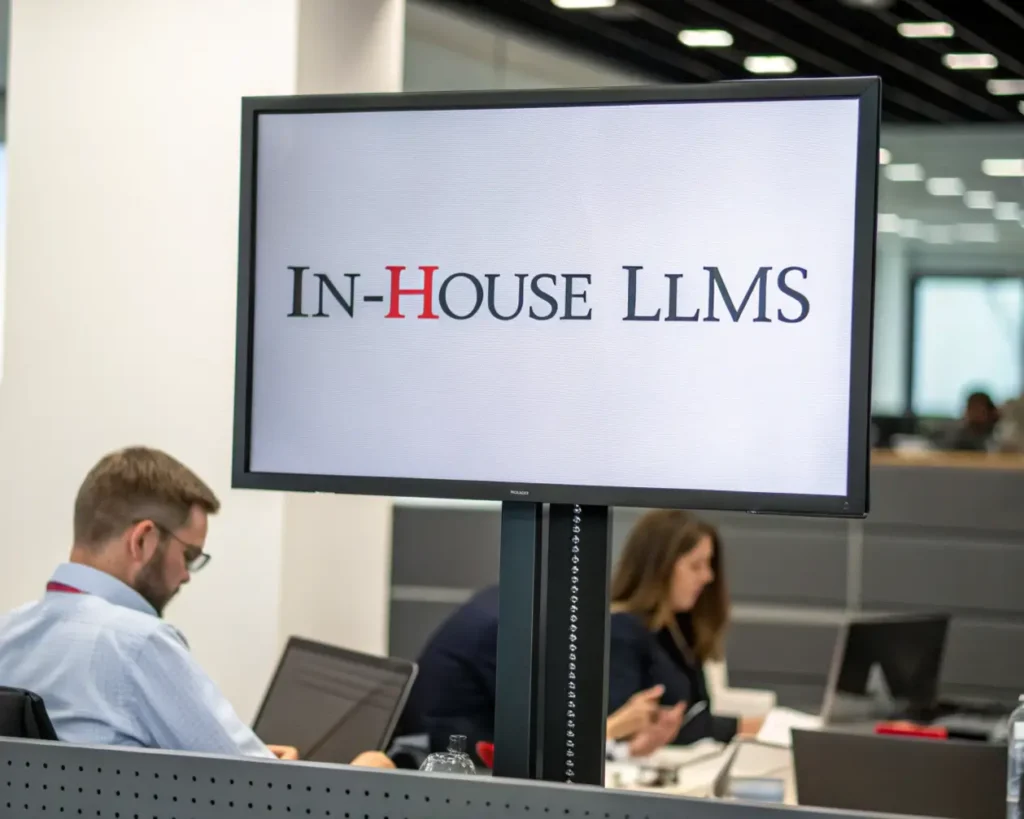Introduction
In today’s fast-paced world of artificial intelligence, Large Language Models (LLMs) have become essential tools for businesses across a wide range of industries. While cloud-based solutions have dominated the AI scene, a new trend is emerging: in-house LLMs. As organizations seek greater control, customization, and security for their AI applications, running LLMs on-premise is gaining traction.
This shift towards local AI deployment isn’t just a fleeting trend; it’s a strategic move that offers compelling advantages, such as improved data privacy or cost savings. From enhanced data privacy to cost-effectiveness, the benefits of self-hosted machine learning are reshaping how businesses approach AI integration. In this article, we’ll explore five compelling reasons why your organization should consider moving beyond the cloud and embracing the power of in-house LLMs. Let’s explore how this approach could transform your AI strategy, making your business more agile, secure, and efficient in an increasingly AI-driven world.
Understanding In-House LLMs
In-house LLMs, also known as on-premise AI or private language models, represent a paradigm shift in how organizations deploy and utilize artificial intelligence. Unlike cloud-based solutions that depend on remote servers managed by third-party providers, in-house LLMs are hosted and run on your organization’s own infrastructure, giving you greater control.
The concept of local AI deployment involves running sophisticated language models on dedicated hardware within the company’s physical or virtual premises. This approach offers a level of control and customization that cloud-based alternatives often can’t match. According to a recent survey by Gartner, 35% of organizations are planning to implement some form of on-premise AI within the next two years, highlighting the growing interest in this technology, driven by increased data privacy concerns and the desire for greater control over AI systems.
When comparing in-house LLMs to cloud-based solutions, several key differences emerge:
- Data Control: In-house LLMs allow organizations to maintain complete control over their data, as it never leaves the company’s infrastructure.
- Customization: On-premise AI can be fine-tuned to specific industry needs and company data, potentially offering more accurate and relevant outputs.
- Performance: Local AI deployment can reduce latency, especially for applications requiring real-time processing.
- Cost Structure: While initial setup costs may be higher, in-house LLMs can be more cost-effective in the long run for organizations with high usage volumes.
Dr. Emily Chen, AI Research Director at TechFuture Institute, explains, „The shift towards in-house LLMs is not just about technology; it’s about aligning AI capabilities with business strategies and data governance policies. For instance, a financial firm recently implemented an in-house LLM to enhance their risk assessment models, aligning their AI tools directly with their strategic goal of minimizing operational risk.” Organizations are recognizing the value of having a more intimate relationship with their AI models.”
5 Compelling Reasons to Run Your LLM In-House
A. Enhanced Data Privacy and Security
In an era where data breaches and privacy concerns are at the forefront of business risks, running LLMs in-house offers a significant advantage in terms of data privacy and security. When organizations use cloud-based LLMs, they often need to share sensitive data with third-party providers, potentially exposing themselves to security vulnerabilities and compliance issues.
With private language models, companies can ensure that sensitive data is always processed securely on their own systems, reducing risks associated with third-party handling. This is particularly crucial for industries dealing with highly sensitive information, such as healthcare, finance, and government sectors. According to a report by IBM, the average cost of a data breach in 2023 was $4.45 million, emphasizing the financial implications of data security.
Moreover, in-house LLMs help organizations comply with stringent data protection regulations such as GDPR, HIPAA, and CCPA. John Smith, Chief Information Security Officer at DataGuard Solutions, states, „On-premise AI allows companies to implement granular access controls and encryption measures tailored to their specific security protocols, significantly reducing the risk of unauthorized data access or breaches.”
Key benefits of enhanced data privacy and security with in-house LLMs include:
- Complete control over data storage and processing
- Ability to implement custom security measures
- Easier compliance with industry-specific regulations
- Reduced risk of data exposure to third parties
B. Customization and Fine-tuning Capabilities
One of the most compelling reasons to run LLMs in-house is the unparalleled level of customization and fine-tuning capabilities it offers. While cloud-based solutions provide pre-trained models, they often lack the flexibility to adapt to specific industry jargon, company-specific data, or unique use cases.
With self-hosted machine learning, organizations can fine-tune their models using proprietary data, ensuring that the AI understands the nuances of their business language and processes. This level of customization can lead to more accurate outputs and better decision-making support.
Dr. Sarah Johnson, AI Research Lead at InnovateAI, explains, „In-house LLMs allow companies to create AI models that are truly extensions of their business intelligence. By training on company-specific data, these models can capture the subtle complexities of an organization’s operations, leading to more relevant and actionable insights.”
The benefits of customization extend beyond just accuracy. They include:
- Ability to incorporate domain-specific knowledge
- Continuous improvement based on real-time feedback and new data
- Development of unique AI capabilities that can serve as a competitive advantage
- Flexibility to adapt the model to changing business needs quickly
A study by MIT Sloan Management Review found that companies using customized AI models reported a 36% higher satisfaction rate with their AI implementations compared to those using off-the-shelf solutions.
C. Reduced Latency and Improved Performance
In the fast-paced business environment, every millisecond counts. Local AI deployment offers significant advantages in terms of reduced latency and improved performance, especially for applications requiring real-time processing.
When LLMs are run in-house, the physical proximity of the hardware to the data source and end-users dramatically reduces the time it takes for data to travel. This reduction in latency can be critical for applications such as real-time customer service chatbots, financial trading algorithms, or manufacturing process controls.
According to a benchmark study by AI Performance Quarterly, on-premise LLMs showed an average latency reduction of 65% compared to cloud-based alternatives for similar tasks. This improvement in response time can translate to better user experiences, more efficient operations, and in some cases, a competitive edge in time-sensitive industries.
Mark Thompson, CTO of SpeedTech Solutions, notes, „For businesses where every microsecond matters, the performance gains from in-house LLMs can be game-changing. We’ve seen clients in high-frequency trading and real-time analytics achieve performance improvements that directly impact their bottom line.”
Key performance benefits of local AI deployment include:
- Significantly reduced response times for AI-driven applications
- Ability to handle larger volumes of requests without performance degradation
- Improved reliability and consistency in AI model performance
- Enhanced capacity for real-time data processing and decision-making
D. Cost-effectiveness in the Long Run
While the initial investment in hardware and infrastructure for in-house LLMs can be substantial, many organizations find that it becomes cost-effective in the long run, especially for high-volume use cases. The economics of on-premise AI versus cloud-based solutions depend on factors such as usage patterns, data volume, and specific business requirements.
Cloud-based LLM services usually work on a pay-per-use model, which can quickly become costly for organizations with regular, high-volume AI needs. In contrast, once the initial setup costs are absorbed, in-house LLMs can offer more predictable and potentially lower long-term costs.
A TCO (Total Cost of Ownership) analysis by Enterprise Strategy Group revealed that for companies with sustained AI workloads, in-house LLMs could result in cost savings of up to 30-40% over a three-year period compared to cloud-based alternatives.
Lisa Chen, CFO of AI Innovate Corp, shares her experience: „After our initial investment in on-premise AI infrastructure, we saw our monthly AI-related costs decrease by 45% within the first year. Compared to the fluctuating costs of cloud-based solutions, our in-house system provided a more predictable and cost-effective approach.” The ROI has been significant, especially as we scaled our AI operations.”
Considerations for cost-effectiveness include:
- Predictable costs without unexpected usage spikes
- Ability to leverage existing IT infrastructure and expertise
- Potential for energy cost optimization through efficient hardware utilization
- Scalability options that align with business growth without proportional cost increases
E. Full Control and Ownership
Perhaps one of the most compelling reasons to run LLMs in-house is the full control and ownership it provides. With private language models, organizations have complete autonomy over their AI systems, from the training data used to the specific algorithms employed.
This level of control is particularly valuable for companies developing proprietary AI solutions or those operating in highly regulated industries. By maintaining full ownership of their AI models, businesses can protect their intellectual property and maintain a competitive edge in the market.
Dr. Robert Lee, Director of AI Ethics at TechResponsibility, emphasizes the importance of this aspect: „When organizations run their LLMs in-house, they’re not just gaining technical control; they’re taking ownership of their AI destiny. This includes the ability to ensure ethical AI use, maintain transparency, and align AI operations with company values.”
Key benefits of full control and ownership include:
- Independence from third-party providers and their potential limitations or changes
- Ability to implement custom governance and ethical frameworks
- Protection of proprietary algorithms and training data
- Flexibility to integrate AI seamlessly with existing systems and workflows
A survey by the AI Governance Institute found that 78% of companies cited „maintaining control over AI decision-making processes” as a primary reason for considering in-house LLMs.
Q: What are the hardware requirements for running LLMs in-house?
A: Hardware requirements vary based on the size and complexity of the LLM. Typically, you’ll need high-performance GPUs, substantial RAM (often 32GB or more), and ample storage. For large models, a cluster of machines may be necessary. It’s crucial to consult with AI infrastructure specialists to determine the exact specifications for your use case.
Q: How long does it take to implement an in-house LLM solution?
A: The implementation timeline can range from a few months to over a year, depending on factors such as the complexity of your use case, existing infrastructure, and team expertise. This includes time for hardware setup, model selection and fine-tuning, integration with existing systems, and staff training.
Q: Are in-house LLMs suitable for small to medium-sized businesses?
A: While traditionally more common in larger enterprises, in-house LLMs are becoming increasingly accessible to SMBs. Cloud-to-edge solutions and more efficient models are making local AI deployment more feasible. However, SMBs should carefully evaluate their needs, resources, and long-term AI strategy before committing to an in-house solution.
Q: How do in-house LLMs handle updates and improvements to the model?
A: With in-house LLMs, organizations have full control over updates and improvements. This typically involves regularly fine-tuning the model with new data, implementing the latest algorithms, and potentially swapping out the base model for newer versions. It requires a dedicated team to monitor advancements in the field and apply relevant updates.
Q: What are the main challenges in maintaining an in-house LLM?
A: Key challenges include:
- Keeping up with rapid advancements in AI technology
- Ensuring consistent performance and reliability
- Managing the high energy consumption of AI hardware
- Maintaining a team of skilled AI professionals
- Balancing model accuracy with computational efficiency
- Ensuring ongoing compliance with evolving data regulations
Frequently Asked Questions About In-House LLMs
Q: What are the hardware requirements for running LLMs in-house?
A: Hardware requirements vary based on the size and complexity of the LLM. Typically, you’ll need high-performance GPUs, substantial RAM (often 32GB or more), and ample storage. For large models, a cluster of machines may be necessary. It’s crucial to consult with AI infrastructure specialists to determine the exact specifications for your use case.
Q: How long does it take to implement an in-house LLM solution?
A: The implementation timeline can range from a few months to over a year, depending on factors such as the complexity of your use case, existing infrastructure, and team expertise. This includes time for hardware setup, model selection and fine-tuning, integration with existing systems, and staff training.
Q: Are in-house LLMs suitable for small to medium-sized businesses?
A: While traditionally more common in larger enterprises, in-house LLMs are becoming increasingly accessible to SMBs. Cloud-to-edge solutions and more efficient models are making local AI deployment more feasible. However, SMBs should carefully evaluate their needs, resources, and long-term AI strategy before committing to an in-house solution.
Q: How do in-house LLMs handle updates and improvements to the model?
A: With in-house LLMs, organizations have full control over updates and improvements. This typically involves regularly fine-tuning the model with new data, implementing the latest algorithms, and potentially swapping out the base model for newer versions. It requires a dedicated team to monitor advancements in the field and apply relevant updates.
Q: What are the main challenges in maintaining an in-house LLM?
A: Key challenges include:
- Keeping up with rapid advancements in AI technology
- Ensuring consistent performance and reliability
- Managing the high energy consumption of AI hardware
- Maintaining a team of skilled AI professionals
- Balancing model accuracy with computational efficiency
- Ensuring ongoing compliance with evolving data regulations
Conclusion
The shift towards in-house LLMs represents a significant evolution in the AI landscape, offering compelling advantages for organizations seeking greater control, customization, and security in their AI implementations. From enhanced data privacy and reduced latency to cost-effectiveness and full ownership, the benefits of local AI deployment are clear. While challenges exist, the potential for tailored AI solutions that align perfectly with business needs and values makes in-house LLMs an attractive option for many companies.
As AI continues to shape the future of business, the decision to bring LLMs in-house could be a game-changer for your organization. It’s an opportunity to not just adopt AI, but to truly own and shape it to your specific requirements.
What can we do for you
Institute AI can help your organization deploy the best available LLM models, train them on your proprietary data securely, and ensure they are updated as new models become available. Their expertise makes it easier for businesses to stay at the cutting edge of AI technology without sacrificing data privacy.
Don’t let your organization fall behind in the AI race. Take the first step towards harnessing the power of in-house LLMs:
- Assess your current AI needs and future goals.
- Consult with AI infrastructure specialists to understand the requirements for your specific use case.
- Conduct a cost-benefit analysis comparing in-house LLMs to cloud-based solutions.
- Start small with a pilot project to test the waters of local AI deployment.
Remember, the future of AI is not just about using technology—it’s about owning it. Explore the possibilities of in-house LLMs today and position your business at the forefront of the AI revolution.



